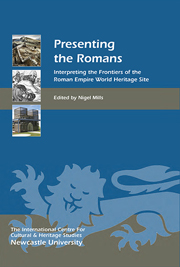Book contents
- Frontmatter
- Contents
- List of Illustrations
- Acknowledgments
- List of Abbreviations
- Preface
- Introduction: Presenting the Romans – Issues and Approaches to Interpretation
- 1 Tradition and Innovation: Creating a New Handbook to the Roman Wall
- 2 Re-enactment and Living History – Issues about Authenticity
- 3 Reconstruction Drawings: Illustrating the Evidence
- 4 Images from the Past: Fibulae as Evidence for the Architectural Appearance of Roman Fort Gates
- 5 Multimedia Interpretation Techniques for Reconstructing the Roman Past at the Limes Museum in Aalen and at the Limes in Baden-Württemberg
- 6 Vindonissa: Changing Presentations of a Roman Legionary Fortress
- 7 Bringing to Life the Ancient City of Viminacium on the Danube
- 8 An International View of Reconstruction
- 9 A Roman Museum for Vienna
- 10 Woerden – Hoochwoert (Dutch Limes): Showing the Invisible
- 11 Mainlimes Mobil: Presenting Archaeology and Museums with the Help of Smartphones
- 12 Voices from the Past: Presenting (re)Constructed Environments through Multimedia Technologies
- 13 Digital Reconstruction and the Public Interpretation of Frontiers
- 14 Information, Disinformation and Downright Lies: Portraying the Romans
- 15 Romanes eunt Domus?
- 16 The Living Frontier: the Passing of Time on Hadrian's Wall
- 17 The Hadrian's Wall Interpretation Framework: Audience Research
- 18 The Hadrian's Wall Interpretation Framework
- 19 Applying the Hadrian's Wall Interpretation Framework
- List of Contributors
- Index
- Heritage Matters
Preface
Published online by Cambridge University Press: 05 September 2013
- Frontmatter
- Contents
- List of Illustrations
- Acknowledgments
- List of Abbreviations
- Preface
- Introduction: Presenting the Romans – Issues and Approaches to Interpretation
- 1 Tradition and Innovation: Creating a New Handbook to the Roman Wall
- 2 Re-enactment and Living History – Issues about Authenticity
- 3 Reconstruction Drawings: Illustrating the Evidence
- 4 Images from the Past: Fibulae as Evidence for the Architectural Appearance of Roman Fort Gates
- 5 Multimedia Interpretation Techniques for Reconstructing the Roman Past at the Limes Museum in Aalen and at the Limes in Baden-Württemberg
- 6 Vindonissa: Changing Presentations of a Roman Legionary Fortress
- 7 Bringing to Life the Ancient City of Viminacium on the Danube
- 8 An International View of Reconstruction
- 9 A Roman Museum for Vienna
- 10 Woerden – Hoochwoert (Dutch Limes): Showing the Invisible
- 11 Mainlimes Mobil: Presenting Archaeology and Museums with the Help of Smartphones
- 12 Voices from the Past: Presenting (re)Constructed Environments through Multimedia Technologies
- 13 Digital Reconstruction and the Public Interpretation of Frontiers
- 14 Information, Disinformation and Downright Lies: Portraying the Romans
- 15 Romanes eunt Domus?
- 16 The Living Frontier: the Passing of Time on Hadrian's Wall
- 17 The Hadrian's Wall Interpretation Framework: Audience Research
- 18 The Hadrian's Wall Interpretation Framework
- 19 Applying the Hadrian's Wall Interpretation Framework
- List of Contributors
- Index
- Heritage Matters
Summary
‘But Dad, history is boring and the Romans are the most boring bit of it all.’ I may have paraphrased my son's attempted justification for not doing homework but the essence of his argument is, and was, very plain. A similar argument was deployed always when discussing going to visit one of the site museums on Hadrian's Wall; and yet a walk along the Wall where ‘British war parties’ (children), waiting in ambush for Roman supply columns (parents), were routinely ‘flushed-out’ by Roman scouts (the dog) but rallied to win the ensuing battle, were, for a time, one of the most attractive of weekend activities.
Where have we, as teachers, academics and interpreters gone so badly wrong? How have we managed to make the Romans such a hated topic? Readers may think I overreact but on a very brief and totally unsystematic survey (conducted in the last few minutes with two of my children and eight of their friends, home for lunch from school), the result was almost unanimous: the Romans are the most boring part of history — with one dissenter identifying ‘Medicine Through Time’ (although, when pressed by his peers, he acknowledged that the worst bit of this was ‘The Romans and the beginning of public health’ as there was no gruesome dissection or surgery to talk of …).
- Type
- Chapter
- Information
- Presenting the RomansInterpreting the Frontiers of the Roman Empire World Heritage Site, pp. xiii - xivPublisher: Boydell & BrewerPrint publication year: 2013

